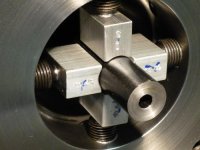Kiwi, you can go 4 inches in either direction, and there is a good chance that the off center will not be in the same proportion, or even in the same plain.
I stand by what I said. I have done hundreds of custom barrels, and have never seen one that had a bannana curve that was consistant throughout the bore. All, however, exibit, to varying degrees, spots in the ID where the Gun drill, for what ever reason, meandered one way or the other.
If you think about the very nature of gun drilling and the way it works, one of the more improbable senarios would be a hole that was a constant curve. You would have to say, "how did it do that"? Not very likely.
In the current manufacturing of Rifle barrels that are not produced by a hammer forged method, everything is predicated on the initial gun drilling of the blank. No reaming, lapping, rifling, or anything else will correct any flaws in straightness that are a result of this proccess. The only thing that will correct it is either some type of single point boring, (obviously not practicle), or a honing proccess, which as the OP pointed out, can produce a perfectly straight hole. That is, if the technology has truly advanced to the point to where this type of honing is practicle in such small holes of such great length.
One problem is that in order to have stock for the hone to remove and accomplish it's purpose, the initial gun drill must produce a hole that is withing that .005 to .006 of being straight with its self for it's entire length. Any sopts outside that perameter will leave a shadow of different diameter. From my experience, this is no easy task unless you are willing to accept a rather high scrap rate.
I am intrigued by this. ........jackie


